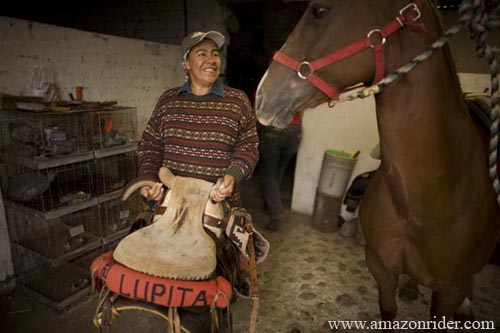 |
| Carlos Pascual at La Metro rodeo club in Mexico City. Photo by Leslie Mazoch |
Carlos Enrique Pascual Lopez was "the one" escaramuza riders had been waiting for. He was in a position of power that could change everything.
Carlos Pascual was the president of the Mexican Charreria Federation, and the first such leader who agreed with them that their sport was just that, a sport, and part of charreria, Mexico's official sport since 1931. The year was 1991.
The voting council was, and continues to be, comprised of only the male members of the charreria rodeo clubs across the country. Pascual pushed his colleagues to vote on adding the escaramuza to the list of charreria sports.
Thirty-eight years had gone by since the first escaramuza, which evolved from horse riding lessons for six little kids, three girls and three boys, at the Rancho Charro in Mexico City, today known as the National Association of Charros rodeo club.
 |
| Photo courtesy of Carlos Pascual, sitting at center. Also in the picture are Rafael Abaniano, second from left, and Carlos Sanchez Llaguno, second from right. |
Pascual received a hallow death threat for pushing such an issue to a vote, but the council voted "yes." Since then, the women who ride on escaramuza teams are treated as athletes.
Escaramuza teams now compete at a very specific time during charreria rodeo events, instead of waiting on the sidelines for the men to finish their competition. The escaramuza teams enter the arena after "colas," or "tails," referring to the sport of knocking down a steer by twisting its tail, and their routines are limited to 12 minutes.
 |
| Carlos Pascual at La Metro rodeo club in Mexico City. Photo by Leslie Mazoch |
Pascual supported the integration of women in Mexico's traditionally male sport because, as he saw it, charreria was fading and sports like soccer were becoming more popular.
The inclusion of women was just one piece of his overall plan to revive his beloved sport. He also wanted children to compete. He wanted Mexico's youth at the arenas as well, joining the rest of the family.
The women who pushed their sport into charreria are many. In the 60s, 70s and 80s, they organized themselves and learned how to ride as a team, even though they couldn't officially compete and could not count on federation resources. Their persistence and whole hearted love for their sport is a lesson in persistence and going forward with what one loves no matter the obstacles.
 |
| Carlos Pascual and his son Miguel at La Metro rodeo club in Mexico City. Photo by Leslie Mazoch |
Watch a an
audio-slide show about the story of the escaramuza
including an interview with Carlos Pascual by photojournalist Leslie Mazoch.








